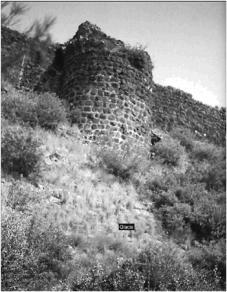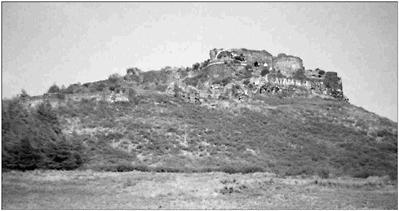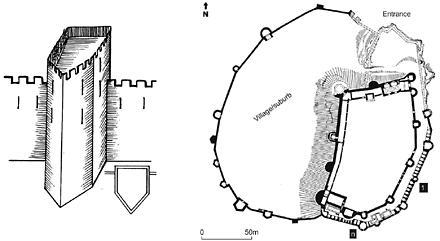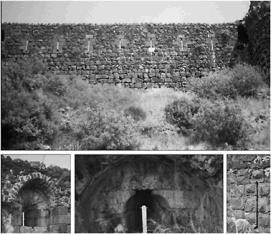Muslim Fortresses in the Levant: Between Crusaders and Mongols (110 page)
Read Muslim Fortresses in the Levant: Between Crusaders and Mongols Online
Authors: Kate Raphael
Tags: #Arts & Photography, #Architecture, #Buildings, #History, #Middle East, #Egypt, #Politics & Social Sciences, #Social Sciences, #Human Geography, #Building Types & Styles, #World, #Medieval, #Humanities

Among Mamluk fortresses captured and restored Tall rates as fairly modest in size. The core measures 60m in width, while the length is approximately 200m. The southern and eastern sides ere protected by two lines of walls; the western side had larger towers and an impressive glacis (
rates as fairly modest in size. The core measures 60m in width, while the length is approximately 200m. The southern and eastern sides ere protected by two lines of walls; the western side had larger towers and an impressive glacis (
Figure 4.50
).
The little village or (suburb) that grew along the slope adjacent to Tall
(suburb) that grew along the slope adjacent to Tall was surrounded by a narrow wall (1.8m) that was linked to the fortress. The towers along it are small and assume an unusual variety of shapes: octagonal, horseshoe, rectangular and semi-circular (
was surrounded by a narrow wall (1.8m) that was linked to the fortress. The towers along it are small and assume an unusual variety of shapes: octagonal, horseshoe, rectangular and semi-circular (
Figure 4.51
). There is no evidence of arrow slits or galleries; thus the protection provided was only nominal. According to Foss and Winfield this line of prow-shaped towers along the village wall dates to the Byzantine period (late eleventh century) (
Figure 4.52
).
283
One could only enter the fortress by first walking through the village compound. Turning up through the narrow passage you come to the main gate, flanked by two semi-circular towers built by the Mamluks to reinforce the existing structure (
Figure 4.53
).
In contrast to which is almost devoid of towers, Tall
which is almost devoid of towers, Tall has a dense line of towers along both the inner and the outer curtain walls. Judging by the shapes of the towers and the design of the arrow slits it seems the majority belong to an Armenian phase, probably of the late eleventh or early twelfth century. Horseshoe towers were not part of the Mamluk inventory, but appear to be a design favored in Armenian military architecture.
has a dense line of towers along both the inner and the outer curtain walls. Judging by the shapes of the towers and the design of the arrow slits it seems the majority belong to an Armenian phase, probably of the late eleventh or early twelfth century. Horseshoe towers were not part of the Mamluk inventory, but appear to be a design favored in Armenian military architecture.
284
Extensive Mamluk repairs were carried out along the archers’ galleries. The large specious chamber in front of the arrow slits serve as a Mamluk trademark. The stirrup at the base increased the angle of fire and allowed archers to aim at objects positioned directly below them (
Figure 4.53
). By the end of the Mamluk building phase there were thirteen towers along the inner circumference, which measured 380m.

Figure 4.50 , Mamluk tower and glacis along the western inner wall
, Mamluk tower and glacis along the western inner wall

Figure 4.51 , view from the southwest
, view from the southwest

Figure 4.52 , prow-shaped tower along the lower curtain wall and site plan. Note the Mamluk galleries (1) and the new Mamluk tower along the Armenian walls (n)
, prow-shaped tower along the lower curtain wall and site plan. Note the Mamluk galleries (1) and the new Mamluk tower along the Armenian walls (n)
